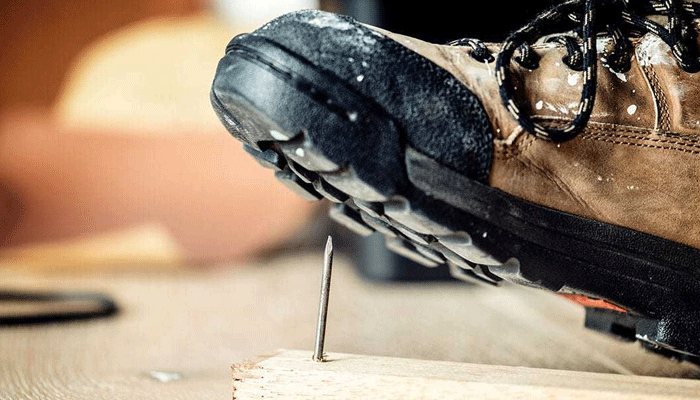
Safety boots are essential footwear for many workers who face various hazards and risks in their jobs. Whether you work in construction, manufacturing, agriculture, or any other industry that involves heavy machinery, tools, or materials, you need to protect your feet from potential injuries and accidents. In this article, we will explain why safety boots are important in the workplace, what types of safety boots are available, and how to choose and maintain your safety boots properly.
Why Safety Boots are Important in the Workplace
According to the Bureau of Labor Statistics, there were 5,900 foot injuries in the private sector in 2021, resulting in days away from work. These injuries included fractures, sprains, strains, cuts, bruises, amputations, and burns. Some of the common causes of foot injuries in the workplace are:
• Falling or rolling objects, such as tools, equipment, or materials, that can crush or break your toes or feet.
• Sharp objects, such as nails, glass, or metal, that can puncture or cut your soles or feet.
• Slippery or uneven surfaces, such as oil, water, or gravel, that can cause you to slip, trip, or fall, and twist or sprain your ankles or feet.
• Electrical hazards, such as live wires, power cords, or outlets, that can shock or electrocute you through your feet.
• Chemical hazards, such as acids, solvents, or fuels, that can splash or spill on your feet and cause burns or skin irritation.
• Extreme temperatures, such as fire, steam, or cold, that can burn or freeze your feet.
These hazards can cause serious and sometimes irreversible damage to your feet, affecting your mobility, health, and quality of life. They can also result in lost work time, reduced productivity, increased medical costs, and legal liabilities. Therefore, it is important to wear safety boots in the workplace, as they can provide the following benefits:
• Protection: Safety boots can shield your feet from various hazards and risks, by offering features such as steel or composite toe caps, puncture-resistant soles, slip-resistant outsoles, electrical insulation, and heat or cold resistance. These features can prevent or minimize the impact of injuries and accidents on your feet, and save you from pain, suffering, and disability.
• Comfort: Safety boots can also enhance your comfort and well-being, by offering features such as cushioned insoles, padded collars, breathable linings, and ergonomic designs. These features can support your feet and ankles, reduce fatigue and stress, and improve your blood circulation and posture. They can also prevent or relieve common foot problems, such as blisters, calluses, corns, and bunions.
• Compliance: Safety boots can also help you comply with occupational safety and health regulations and standards, such as the OSHA and the ANSI, which require employers and employees to Wear the proper personal protection equipment (PPE) at work. By wearing safety boots, you can demonstrate your awareness and responsibility for your own and others’ safety, and avoid penalties, fines, or lawsuits. Consider using a Hard Yakka Promo Code to invest in quality safety boots while enjoying potential savings on your purchase.
Types of Safety Boots
There are different types of safety boots available in the market, depending on the level of protection, the style, and the material. Some of the common types of safety boots are:
• Steel toe boots: These are boots that have a steel cap embedded in the toe area, to protect your toes from falling or rolling objects. They are the most durable and reliable type of safety boots, but they can also be heavy, bulky, and uncomfortable. They are suitable for jobs that involve heavy machinery, equipment, or materials, such as construction, mining, or engineering.
• Composite toe boots: These are boots that have a composite cap made of plastic, fiberglass, or carbon fiber, to protect your toes from falling or rolling objects. They are lighter, more comfortable, and more flexible than steel-toe boots, but they are also less durable and resistant. They are suitable for jobs that involve moderate hazards, such as manufacturing, warehousing, or transportation.
• Soft toe boots: These are boots that do not have any toe cap, but still offer some protection and comfort for your feet. They are the lightest, most comfortable, and most stylish type of safety boots, but they are also the least protective and resistant. They are suitable for jobs that involve low or minimal hazards, such as retail, hospitality, or administration.
• Waterproof boots: These are boots that have a waterproof membrane or coating, to prevent water or moisture from entering your boots. They are ideal for jobs that involve damp conditions, such as plumbing, landscaping, or fishing.
• Insulated boots: These are boots that have an insulated layer or lining, to keep your feet warm in cold temperatures. They are ideal for jobs that involve cold or freezing conditions, such as snow removal, refrigeration, or outdoor work.
• Electric hazard boots: These are boots that have an electrically insulated sole to prevent electric shocks or currents from passing through your feet. They are ideal for jobs that involve electrical hazards, such as electricians, technicians, or power plant workers. When considering safety boots with electrical insulation features, explore potential savings with an Apparel & Clothing Promo Code for a cost-effective purchase.
How to Choose and Maintain Your Safety Boots
Choosing the right safety boots for your job is crucial, as it can affect your safety, comfort, and performance. Here are some tips on how to choose and maintain your safety boots:
• Choose safety boots that match the hazards and risks of your job. You should consult your employer, your safety manager, or your safety manual, to find out what type of safety boots are required or recommended for your job. You should also consider the frequency, intensity, and duration of your exposure to the hazards and risks, and choose safety boots that offer adequate and appropriate protection.
• Choose safety boots that fit your feet properly. You should measure your feet and try on different sizes and styles of safety boots, to find the ones that fit you best. You should also wear socks that are similar to the ones you will wear at work, and walk around in the safety boots for a while, to check for comfort and stability. You should avoid safety boots that are too tight, too loose, too narrow, or too wide, as they can cause discomfort, pain, or injury.
• Choose safety boots that are made of quality materials and have good craftsmanship. You should look for safety boots that are made of durable, breathable, and water-resistant materials, such as leather, rubber, or nylon. You should also look for safety boots that have sturdy, slip-resistant, and puncture-resistant soles, such as rubber, polyurethane, or TPU. You should also look for safety boots that have strong, secure, and comfortable closures, such as laces, zippers, or Velcro. You should avoid safety boots that are made of cheap, flimsy, or synthetic materials, or that have weak, loose, or broken closures.
• Maintain your safety boots regularly and properly. You should clean your safety boots regularly, by wiping off any dirt, dust, or debris, and washing them with mild soap and water, if needed. You should also condition your safety boots occasionally, by applying a leather conditioner or a waterproofing spray, to keep them soft, supple, and water-resistant. You should also inspect your safety boots frequently, by checking for any cracks, holes, tears, or wear and tear, and repairing or replacing them, if necessary. You should also store your safety boots in a cool, dry, and dark place, away from heat, moisture, or sunlight, to prevent them from fading, cracking, or molding.
Conclusion
Safety boots are essential footwear for many workers who face various hazards and risks in their jobs. They can protect your feet from injuries and accidents, enhance your comfort and well-being, and help you comply with safety regulations and standards. There are different types of safety boots available in the market, depending on the level of protection, the style, and the material. You should choose safety boots that match the hazards and risks of your job, fit your feet properly, are made of quality materials, and have good craftsmanship. You should also maintain your safety boots regularly and properly, to keep them in good condition and extend their lifespan. By wearing safety boots in the workplace, you can ensure your safety, comfort, and performance, and avoid pain, suffering, and disability.








